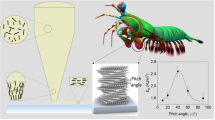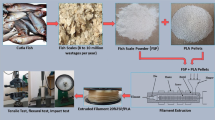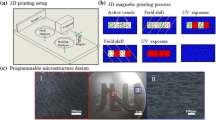Abstract
Taking crustacean organisms in nature as prototypes helps improve the design of protective gears. Drawing inspiration from the high-damage-tolerance helical-structured cuticle of the American crayfish, we conduct an optimization of processing parameters for Fused Filament Fabrication 3D printing products. Various values of in-plane raster angle and interlayer thickness are employed to replicate the damage-resistant feature mimicked from nature. The effect of flexural resistances on 3D-printed three-point bending specimens is being investigated using a combination of four helical printing raster angles at four different layer thicknesses. Acrylonitrile-butadiene-styrene (ABS) and glass fiber-reinforced ABS (ABS-GF) are employed as material models. A Dino-lite handheld microscope and a Keyence VHX-7000 optical microscope are used to characterize the microstructure of the samples’ fracture resistance after the three-point bending test. Explanations of the mechanism of fracture resistance for helical structures are given. The results show that the specimen with a layer thickness of 0.04 mm and a spiral angle of 30° has the highest bending strength and bending elastic modulus among all the tested specimens. When compared with the layer thickness of 0.16 mm, the bending strength and bending elastic modulus of the ABS helix specimen with a layer thickness of 0.04 mm are increased by 6.45% and 2.67%, and those of the ABS-GF helix specimen are increased by 21.21% and 10.03%, respectively. The microstructural observation of the samples reveals that the spiral specimens with a helix angle of 11.25° have a greater displacement of crack propagation to resist the damage extending inside when resisting fracture. Our bio-inspired study presents an alternative approach to comprehensively optimize FFF printing parameters for enhanced mechanical performance.
Graphical Abstract





















Similar content being viewed by others
Data Availability
Data will be made available upon reasonable request.
References
Boulaala, M., Elmessaoudi, D., Buj-Corral, I., et al.: Towards design of mechanical part and electronic control of multi-material/multicolor fused deposition modeling 3D printing. Int. J. Adv. Manuf. Technol. 110, 45–55 (2020)
Ahmadifar, M., Benfriha, K., Shirinbayan, M., et al.: Additive manufacturing of polymer-based composites using fused filament fabrication (FFF): A review. Appl. Compos. Mater. 28, 1335–1380 (2021)
Yilmaz, H., Turan, M.K.: FahamecV1: A Low Cost Automated Metaphase Detection System. Eng. Technol Appl. Sci. Res. 7(6), 2160–2166 (2017)
Weng, Z., Wang, J., Senthil, T., et al.: Mechanical and thermal properties of ABS/montmorillonite nanocomposites for fused deposition modeling 3D printing. Mater. Des. 102, 276–283 (2016)
De Mendonça, A.C., Cavalcanti, D.K.K., De Queiroz, H.F.: Mechanical characterization of Filler modified ABS 3D-printed composites made via Fused Filament Fabrication. Annals of Dunarea De Jos University of Galati. Fascicle XII. Weld. Equip. Technol. 33, 27–34 (2022)
Alomarah, A., Masood, S.H., Ruan, D.: Out-of-plane and in-plane compression of additively manufactured auxetic structures[J]. Aerosp Sci. Technol. 106,(2020)
Alomarah, A., Masood, S.H., Ruan, D.: Dynamic and quasistatic properties of an auxetic structure: A comparative study[J]. Adv. Eng. Mater. 24(9),(2022)
Kain, A., Mueller, C., Reinecke, H.: High aspect ratio-and 3D-printing of freestanding sophisticated structures. Procedia Chem. 1(1), 750–753 (2009)
Chu, J., Engelbrecht, S., Graf, G., et al.: A comparison of synthesis methods for cellular structures with application to additive manufacturing. Rapid Prototyp. J. 16(4), 275–283 (2010)
Mohamed, O.A., Masood, S.H., Bhowmik, J.L.: Optimization of fused deposition modeling process parameters: a review of current research and future prospects. Adv. Manuf. 3(1), 42–53 (2015)
Belarbi, B., Ghernaout, M.E.A., Benabdallah, T.: Implementation of a New Geometrical Qualification (DQ) Method for an Open Access Fused Filament Fabrication 3D Printer. Eng. Technol. Appl. Sci. Res. 9(3), 4182–4187 (2019)
Pati, K.N.V.: Effect of process parameters on the quality of Additively Manufactured PETG-Silk Composite. Appl. Compos. Mater. 30(1), 135–155 (2023)
Mohamed, O.A., Masood, S.H., Bhowmik, J.L.: Optimization of fused deposition modeling process parameters: A review of current research and future prospects. Adv. Manuf. 3, 42–53 (2015)
Li, H., Wang, T., Sun, J., et al.: The effect of process parameters in fused deposition modelling on bonding degree and mechanical properties. Rapid Prototyp. J. 24(1), 80–92 (2018)
Tanveer, M.Q., Haleem, A., Suhaib, M.: Effect of variable infill density on mechanical behaviour of 3-D printed PLA specimen: An experimental investigation. SN Appl. Sci. 1, 1–12 (2019)
Buj-Corral, I., Bagheri, A., Domínguez-Fernández, A., et al.: Influence of infill and nozzle diameter on porosity of FDM printed parts with rectilinear grid pattern. Procedia Manuf. 41, 288–295 (2019)
Ansari, A.A., Kamil, M.: Effect of print speed and extrusion temperature on properties of 3D-printed PLA using fused deposition modeling process. Mater. Today: Proc. 45, 5462–5468 (2021)
Mishra, P.K., Senthil, P., Adarsh, S., et al.: An investigation to study the combined effect of different infill pattern and infill density on the impact strength of 3D-printed polylactic acid parts. Compos. Comm. 24, 100605 (2021)
Yadav, P., Sahai, A., Sharma, R.S.: Strength and surface characteristics of FDM-based 3D-printed PLA parts for multiple infill design patterns. J. Institution Eng. (India): Ser. C 102, 197–207 (2021)
Özen, A., Abali, B.E., Völlmecke, C., et al.: Exploring the role of manufacturing parameters on microstructure and mechanical properties in fused deposition modeling (FDM) using PETG. Appl. Compos. Mater. 28(6), 1799–1828 (2021)
Zisopol, D.G., Nae, I., Portoaca, A.I., et al.: A Statistical Approach of the Flexural Strength of PLA and ABS 3D-printed Parts. Eng. Technol. Appl. Sci. Res. 12(2), 8248–8252 (2022)
Lizenboim, B., Kenig, S., Naveh, N.: The effect of nozzle geometry on the structure and Properties of 3D printed Carbon Polyamide composites. Appl. Compos. Mater. 1–17 (2023)
Żur, P., Kołodziej, A., Baier, A., et al.: Optimization of abs 3D-printing method and parameters. Eur. J. Eng. Sci. Technol. 3(1), 44–51 (2020)
Mohan, D., Bakir, A.N., Sajab, M.S., et al.: Homogeneous distribution of lignin/graphene fillers with enhanced interlayer adhesion for 3D printing filament. Polym. Compos. 42(5), 2408–2421 (2021)
Tymrak, B.M., Kreiger, M., Pearce, J.M.: Mechanical properties of components fabricated with open-source 3-D printers under realistic environmental conditions. Mater. Des. 58, 242–246 (2014)
Lanzotti, A., Grasso, M., Staiano, G., et al.: The impact of process parameters on mechanical properties of parts fabricated in PLA with an open-source 3-D printer. Rapid Prototyp. J. 21(5), 604–617 (2015)
Fernandez-Vicente, M., Calle, W., Ferrandiz, S., et al.: Effect of infill parameters on tensile mechanical behavior in desktop 3D printing. 3D Print Additive Manuf. 3(3), 183–192 (2016)
Ahn, S.H., Montero, M., Odell, D., et al.: Anisotropic material properties of fused deposition modeling ABS. Rapid Prototyp. J. 8(4), 248–257 (2002)
Ziemian, C., Sharma, M., Ziemian, S.: Anisotropic mechanical properties of ABS parts fabricated by fused deposition modelling. Mech. Eng. 23, 159–180 (2012)
Tsouknidas, A., Pantazopoulos, M., Katsoulis, I., et al.: Impact absorption capacity of 3D-printed components fabricated by fused deposition modelling. Mater. Des. 102, 41–44 (2016)
Aloyaydi, B.A., Sivasankaran, S., A mmar H: R. Influence of infill density on microstructure and flexural behavior of 3D-printed PLA thermoplastic parts processed by fusion deposition modeling. AIMS Mater. Sci. 6(6) (2019)
Durgun, I., Ertan, R.: Experimental investigation of FDM process for improvement of mechanical properties and production cost. Rapid Prototyp. J. 20(3), 228–235 (2014)
Sharma, D., Hiremath, S.S.: Compressive and flexural properties of the novel lightweight tailored bio-inspired structures. Thin-Walled Struct. 174, 109169 (2022)
Siddique, S.H., Hazell, P.J., Wang, H., et al.: Lessons from nature: 3D printed bio-inspired porous structures for impact energy absorption–A review. Additive Manuf. 103051 (2022)
Ramakrishna, D., Bala Murali, G.: Bio-inspired 3D-printed lattice structures for energy absorption applications: A review. Proc. Inst. Mechan. Eng. Part L: J. Mater. Des. Appl. 237(3), 503–542 (2023)
ASTM S:. Standard test methods for flexural properties of unreinforced and reinforced plastics and electrical insulating materials. ASTM D790. Annual book of ASTM standards (1997)
Yuan, Y., Yao, X., Liu, B., et al.: Failure modes and strength prediction of thin ply CFRP angle-ply laminates. Compos. Struct. 176, 729–735 (2017)
Yuan, Y., Li, X., Zhang, Q., et al.: Dependence of damage modes on the ply-thickness of ultra-thin-ply composites. Compos. Part C: Open Access 4, 100105 (2021)
Yuan, Y., Zhang, X., Li, X., et al.: Manipulating impact damage modes in composite laminates by helical pitch angle and ply thickness. Eng. Fract. Mech. 265 (2022)
Li, X., Zhang, X., Yuan, Y., et al.: Damage tolerance mechanism of bioinspired hybridization helical composite in lobster homarus americanus. Compos. Part A: Appl. Sci. Manufac. 157 (2022)
Yin, S., Yang, R., Huang, Y., et al.: Toughening mechanism of coelacanth-fish-inspired double-helicoidal composites. Compos. Sci. Technol. 205 (2021)
Liu, J.L., Lee, H.P., Tan, V.B.C.: Effects of inter-ply angles on the failure mechanisms in bioinspired helicoidal laminates. Compos. Sci. Technol. 165, 282–289 (2018)
Ginzburg, D., Pinto, F., Iervolino, O., et al.: Damage tolerance of bio-inspired helicoidal composites under low velocity impact. Compos. Struct. 161, 187–203 (2017)
Liu, J.L., Lee, H.P., Tan, V.B.C.: Failure mechanisms in bioinspired helicoidal laminates. Compos. Sci. Technol. 157, 99–106 (2018)
Zhang, B., Han, Q., Qin, H., et al.: Bending resistance and anisotropy of basalt fibers laminate composite with bionic helical structure. J. Bionic. Eng. 19(3), 799–815 (2022)
Liu, J.L., Lim, E.W.L., Sun, Z.P., et al.: Improving strength and impact resistance of 3D-printed components with helicoidal printing direction. Int. J. Impact Eng. 169 (2022)
An, L., Wu, X., Wang, K., et al.: Crack modes and toughening strategies of bioinspired 3D-printed double-helicoidal architectures. Int. J. Mech. Sci. 253 (2023)
Li, W., Huang, W., **ong, Y., et al.: Failure mechanism and heat treatment effect of 3D-printed bio-inspired helicoidal CF/PEEK composites. Compos. Commun. 37 (2023)
Fabritius, H.O., Sachs, C., Triguero, P.R., et al.: Influence of structural principles on the mechanics of a biological fiber-based composite material with hierarchical organization: The exoskeleton of the lobster Homarus americanus. Adv. Mater. 21(4), 391–400 (2009)
Verma, P., Ubaid, J., Schiffer, A., et al.: Essential work of fracture assessment of acrylonitrile butadiene styrene (ABS) processed via fused filament fabrication additive manufacturing. Int. J. Adv. Manuf. Technol. 113, 771–784 (2021)
Jiang, H., Ren, Y., Liu, Z., et al.: Low-velocity impact resistance behaviors of bio-inspired helicoidal composite laminates with non-linear rotation angle based layups. Compos. Struct. 214, 463–475 (2019)
Baikerikar, P., Turner, C.J.: Comparison of FEA simulations and experimental results for as-built additively manufactured dogbone specimens. Int. J. Adv. Manuf. Technol. 115(9–10), 2839–2851 (2021)
ABAQUS: Version 6.14 User’s Manual. Dassault Systèmes Simulia Corp, Providence, RI, USA (2014)
Zhang, X., Yuan, Y.: Mechanical behavior of bio-inspired crossed-lamellar microstructures for achieving high-performance composites. Eng. Fract. Mech. 289 (2023)
Wang, Z., Smith, D.E.: Finite element modelling of fully-coupled flow/fiber-orientation effects in polymer composite deposition additive manufacturing nozzle-extrudate flow. Compos. Part B Eng. 219 (2021)
Wang, Z., Smith, D.E.: A fully coupled simulation of planar deposition flow and fiber orientation in polymer composites additive manufacturing. Materials 14(10), 2596 (2021)
Funding
This work was supported by the National Natural Science Foundation of China (52101381), the China Postdoctoral Science Foundation (2023M730455), the Department of Education of Liaoning Province (LJKMZ20220366), and the Dalian Human Resources and Social Security Bureau (Dalian City innovation and entrepreneurship support program for returned overseas students of Year-2020).
Author information
Authors and Affiliations
Contributions
Zhaogui Wang: Conceptualization, Methodology, Writing – original draft, Formal analysis, Investigation, Writing – review & editing, Supervision, Funding acquisition.Kexuan Zhou: Writing – original draft, Experiments, Software, Formal analysis, Investigation, Writing – review & editing.Cheng** Bi: Experiments, Formal analysis, Investigation, Writing – review & editing.
Corresponding author
Ethics declarations
Competing Interests
The authors declare no competing interests.
Additional information
Publisher’s Note
Springer Nature remains neutral with regard to jurisdictional claims in published maps and institutional affiliations.
Highlights
• A crayfish-like biomimetic helical structure is adopted in constructing the interlayer formation of fused filament fabrication 3D-printed parts.
• Different helical angles combined with different deposited layer thicknesses are selected in the preparation of 3D printing three-point bending test specimens made of virgin ABS and its glass-fiber-filled composite.
• Bending test results indicated that the helical-structured interlayers can notably prevent the crack propagation of the printed parts, as compared to commonly printed alternatives.
• A smaller value of the layer thickness yields a higher degree of flexural resistance in the 3D-printed parts, while the bio-inspired helical formation itself does not contribute to the flexural strength increment as compared to the layer thickness parameter.
Appendix
Appendix
1.1 Layer-thickness Precision Study
To ensure the prescribed layer thickness values can be achieved by the employed FFF 3D printer. We perform additional measurements on the layer thickness of the printed specimens. After polishing and smoothing the cross section of the specimens (unidirectional line infill), the Keyence VHX-7000 optical microscope was used to observe the layer thickness of ABS material. Figure 21 provides an example of the measurement, where the cross section of the layer thickness of 0.04 mm, 0.08 and 0.10 mm was observed with 500 × multiple, and the layer thickness of 0.16 mm was observed with 300 × multiple. As seen in Table 3, we selected a series of photographs to count (15 times/ layer-thickness) and calculate the average value and error rate. The accuracy error rate of 40 μm printing layer thickness is 2.33%, which can prove its manufacturing accuracy.
As composite beads exhibit a smaller trend of extrudate die swell as compared to the virgin polymers [55, 56], we would expect that the ABS-GF specimens can also achieve favorable layer thickness precision as did in ABS specimens, and for conciseness, we only added additional experiments on ABS only.
1.2 Mesh Sensitivity Study
We need to consider both time and accuracy based on the detailed division of the grid and the appropriate division of the model. As shown in Fig. 22, we also use 0.5-1 mm, 0.75-1.5 mm, 1.25-2 mm, 1.5-2.5 mm (fine grid to rough grid) grid cell size to divide the sample model, and the grid direction is rough grid to fine grid. The simulation results show that the rougher the grid is, the shorter the time of the simulation results is, and the less accurate the stress distribution is, and the overall state of the stress results after the division of these grid elements is convergent. For the loading roller, the mesh size only needs to be within the range of the sample model mesh, and the simulation results are not much different. As shown in Fig. 23, we use the general mesh size of 0.3 mm, 0.4 mm, 0.6 and 0.7 mm to divide the loading roller model and simulate it in turn. The simulation results are shown in the figure, and the difference in stress results is very small.
Rights and permissions
Springer Nature or its licensor (e.g. a society or other partner) holds exclusive rights to this article under a publishing agreement with the author(s) or other rightsholder(s); author self-archiving of the accepted manuscript version of this article is solely governed by the terms of such publishing agreement and applicable law.
About this article
Cite this article
Wang, Z., Zhou, K. & Bi, C. Exploring Flexural Performances of Fused Filament Fabrication 3D-Printed ABS and ABS-Composites through Innovative Bio-Inspired Processing Parameter Optimization. Appl Compos Mater 31, 929–958 (2024). https://doi.org/10.1007/s10443-023-10191-z
Received:
Accepted:
Published:
Issue Date:
DOI: https://doi.org/10.1007/s10443-023-10191-z







